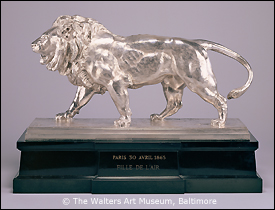 |

|
 |
Antoine-Louis Barye, Walking Lion; Striding Lion (Racing Trophy), 1865, silver on marble plinth, 19 1/2 x 26 3/4 x 8 3/4 in., The Walters Art Museum, Baltimore. This sculpture, whose detailed surface makes it difficult to protect from tarnish, would be a prime candidate to receive a new, nanometers-thick coating being developed by materials scientists and conservators at the Walters Art Museum and the A. James Clark School of Engineering at the University of Maryland. Image courtesy of the Walters Art Museum. |
|
Scientists from the Department of Materials Science and Engineering at the A. James Clark School of Engineering, University of Maryland, have teamed up with conservators from the Walters Art Museum in Baltimore, Md., to develop and test a new, high-tech way to protect silver art objects and artifacts, using coatings that are mere nanometers thick. The technique, called atomic layer deposition (ALD), will be used to create metal oxide films which, when applied to an artifact, are both transparent and optimized to reduce the rate of silver corrosion.
In April 2011 the National Science Foundation's Science Nation web site, which highlights scientific discoveries for the public, debuted a video segment about the project called "Silver Saver," narrated by former CNN chief technology and environment correspondent Miles O?Brien.
The video is available above and online at:
Related Articles:
Using Materials Science and Engineering to Save Priceless Artifacts
Atoms-Thick Coating Ready for First Test on Silver Artifact
Materials Scientists, Conservators Join Forces to Preserve Silver Artifacts and Art
Museum Conservation Research Wins Top Prizes in International 3-Minute Thesis Competition
Vote Now! Materials Grad Student is Finalist in 3 Minute Thesis Competition (VIDEO)
Marquardt Wins Dean’s Doctoral Research Award for “Protecting Art with Nanotechnology”
April 18, 2011
|